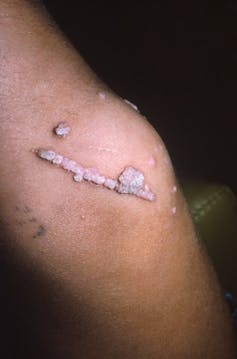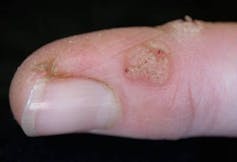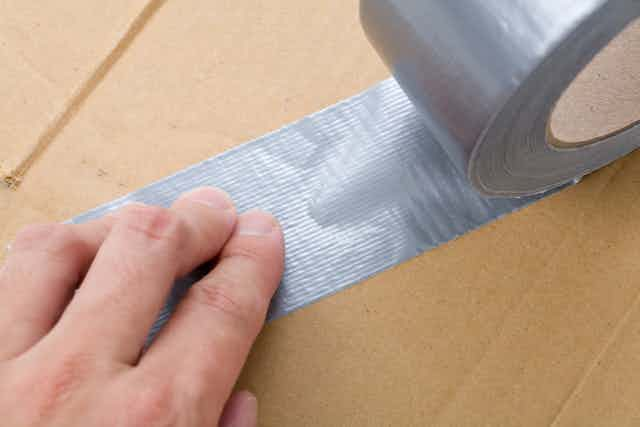Common warts can be hard to get rid of, so many people turn to home remedies. An internet search suggests everything from mashed banana to duct tape. But do these home remedies actually work?
Warts develop when the human papillomavirus (HPV) infects cells in the skin and mucous membranes (the mouth and genitalia). There are more than 150 sub-types of HPV, which cause different types of warts in different parts of the body.
HPV is transmitted through direct contact with another person’s wart or with objects and surfaces exposed to the virus. HPV is more likely to infect skin that is injured, damaged or macerated (such as soggy, sweaty feet). Normal skin can also be infected and it can take more than six months after exposure to the virus for a wart to appear.
Common warts (also called verrucae vulgaris) can occur in any body area, but are most common on the fingers, hands, knees and elbows as these are parts commonly injured. Warts begin as round or oval raised lumps on the skin and can be lighter or darker than the skin around them. They can contain black spots called “seeds”.

Children and young adults are most at risk of developing common warts. Certain jobs, including handling meat, fish and poultry, can also increase your risk. People with skin conditions, such as eczema, are also more likely to develop them, as are those with any condition that weakens their immune system (such as AIDS).
What does the research say?
Not every wart needs to be treated. But if you are concerned about pain or discomfort, how it looks and the risk of a wart spreading to another part of the body, you may want to treat it.
Salicylic acid has the strongest evidence as first-line treatment for common warts. This is the most common ingredient in wart paints which, as the name suggests, are treatments you apply to the skin. Products containing salicylic acid come as a lotion, ointment, pad or patch, which you can buy at a pharmacy without a prescription. Common examples include Duofilm and Wart Off.
First, soak the wart in warm water and rub it with a pumice stone before applying the treatment.
Another option is to freeze a wart by applying liquid nitrogen, which your general practitioner (GP) or dermatologist can do in their office. The doctor sprays liquid nitrogen directly onto the wart for 10-20 seconds in a process known as cryosurgery. But this can be painful, especially for younger children.
These treatments don’t always work and researchers estimate that success rates for over-the-counter wart paints and liquid nitrogen vary from 10% to 90%. This is why many people turn to unconventional home treatments.
The stuff of legends
Home remedies for warts are the stuff of legends. The idea behind many of them is to boost the immune system or break down the wart and the HPV. Where warts seem to improve, it is difficult to tell if the body’s immune system is attacking the wart, or the home remedy is working.

Unconventional treatments include applying apple cider vinegar, cut potatoes, orange peel, aloe vera, clear nail polish, raw garlic, mashed banana or milk of dandelion (its sap).
Unfortunately, there is no research to show they actually work. Part of the problem is some warts simply disappear by themselves, making it hard to say whether the treatment worked or the wart would have disappeared anyway.
What about duct tape?
Researches have studied whether covering the wart with duct tape works, but have had conflicting results. One study found warts improved significantly using duct tape compared with liquid nitrogen, while another found duct tape didn’t help.
Researchers don’t know how duct tape might work. It could suffocate the wart. Alternatively, it could irritate the surrounding skin to produce inflammation. But there is no evidence for either.
If you use duct tape, we suggest using the silver type, which sticks to the skin more effectively than other types of duct tape. Cover the wart for six days, then remove the tape and soak the wart in warm water for 20 minutes. Use a pumice stone to remove the wart. Keep the wart uncovered overnight, then reapply the duct tape for another six days.
If the wart has not responded within two weeks, it is unlikely to respond.
Do not use duct tape if you are at risk of developing ulcers or skin infections, for instance if you have diabetes, poor blood circulation, poor nerve function or have sensitive skin.
Watch out
Never try to remove the wart yourself as this carries a high risk of infection, bleeding and scarring. Self-surgery also increases the risk of the wart spreading. Avoid scratching and picking the wart for the same reasons.
Any topical treatment (from the doctor or a home remedy) may cause an allergic skin reaction. If you see redness or a rash, stop using the treatment immediately and see your doctor.
If you are pregnant or breastfeeding, always consult a doctor before treating a wart; skin treatments are absorbed into the circulation and may harm the unborn baby or breastfeeding infant.
They come, they go, they come back again
Warts in people with working immune systems generally get better without treatment. About 20% resolve within three months and two-thirds within two years. Efforts to promote a healthy immune system, including a healthy diet, exercise and enough sleep, are likely as effective as any home remedy.
Unfortunately, it’s very common for warts to return.
If you have a wart that is causing pain or discomfort, affecting your confidence, or you have recurrent outbreaks, see your GP.

